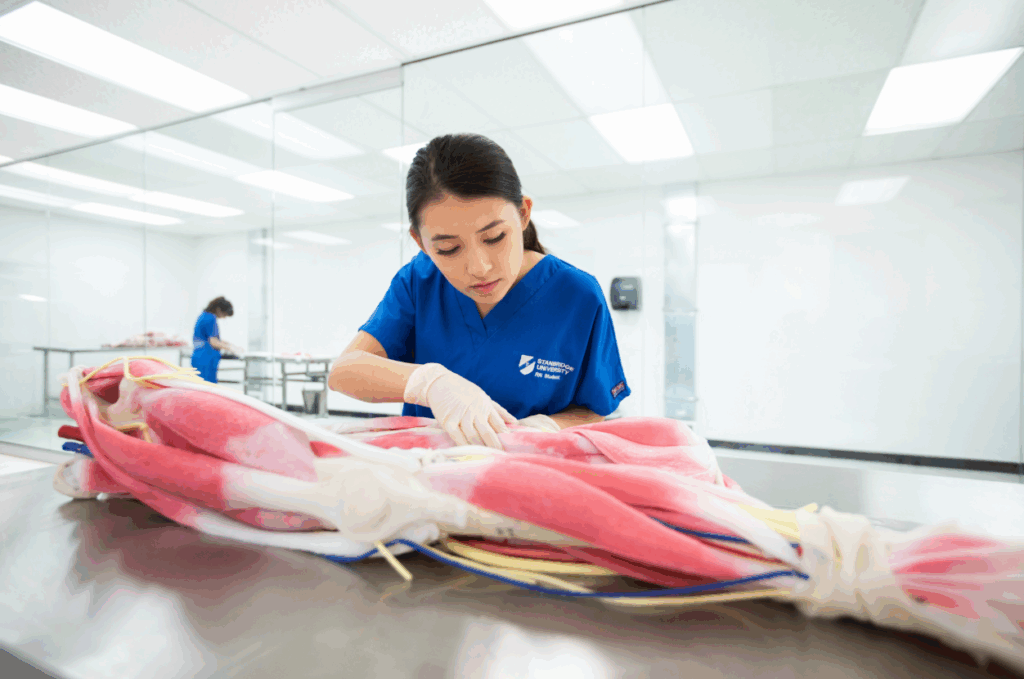How to Become a Registered Nurse Through a BSN Program

Are you seeking information on how to become a registered nurse? Start by earning a Bachelor of Science in Nursing (BSN) from an accredited school. The BSN program typically takes approximately three to four years to complete, combining classroom instruction, laboratory sessions, and clinical training.¹ After graduation, you’ll take the NCLEX-RN exam and apply for state licensure. A BSN not only prepares you to enter the profession, but also opens doors to leadership and advanced nursing roles.¹
Wondering how to become a registered nurse? Many aspiring healthcare professionals share the same goal. Numerous people feel called to nursing because they want to make a real difference in the lives of others. Whether it’s offering comfort to patients, supporting families during difficult times, or contributing to the healthcare team, registered nurses (RNs) make a difference in people’s lives every day.¹
For those ready to take that first step, a Bachelor of Science in Nursing (BSN) program is one of the most direct paths toward becoming an RN.¹ A BSN doesn’t just prepare you for licensure; it helps you build the confidence, clinical skills, and leadership qualities needed to work effectively in healthcare settings.

How to Become an RN with a BSN
The process involves four key steps:
- Earn your BSN degree¹: Choose an accredited program, such as the Bachelor of Science in Nursing (BSN) at Stanbridge University, which provides classroom instruction, simulation-based labs, and practical clinical experiences.
- Gain hands-on training¹: Clinical rotations allow students to apply what they’ve learned while working directly with patients under professional supervision.
- Pass the NCLEX-RN²: This national exam measures your readiness to practice safely and effectively.
- Obtain your state license¹: Once you’ve passed the NCLEX-RN, you’ll apply for licensure through your state’s nursing board.
A BSN program gives future nurses a strong foundation in anatomy, pharmacology, leadership, and patient-centered care. It also prepares them for evolving healthcare environments that require critical thinking and evidence-based decision-making.¹
How Many Years Is BSN to RN?
The time it takes to earn a BSN and become an RN depends on several factors, but most programs require about three to four years of full-time study.¹
Stanbridge University’s BSN program typically takes 36–37 months, including breaks and holidays.³ Students take courses in human biology, nursing fundamentals, and ethics while completing clinical practice in healthcare facilities.
Each year builds your knowledge step by step, from learning essential care techniques to developing the advanced skills needed for complex clinical settings.

Career Advantages of Earning a BSN
A BSN program provides far more than classroom learning. Graduates enter the workforce with:
- A stronger foundation in clinical judgment and communication¹
- Greater employment opportunities across hospitals, clinics, and community health centers⁵
- Pathways to leadership roles or advanced education, such as a Master of Science in Nursing (MSN)¹
Research from the American Association of Colleges of Nursing (AACN) has shown that BSN-prepared nurses are linked to better patient outcomes and higher-quality care.⁵
The BSN Program at Stanbridge University
The Bachelor of Science in Nursing (BSN) program at Stanbridge University is designed to educate students to provide competent, patient-centered care in their communities.
The BSN program takes about 36–37 months to complete³ and offers a well-rounded curriculum that helps graduates build both technical and leadership skills. Stanbridge BSN graduates achieved a 100% NCLEX-RN pass rate for the 2023–2024 academic year, reflecting the strength of Stanbridge University’s curriculum and student support systems.⁶
In addition, eligible Stanbridge BSN graduates may continue into the Master of Science in Nursing Education (MSN-Ed) program at no additional cost, further expanding their professional and academic opportunities.⁷
Stanbridge University Recognition
Stanbridge University offers healthcare degree programs across its Southern California campuses in Irvine, Alhambra, Riverside, and San Marcos. The university has been recognized for both academic excellence and workplace culture, including recognition in the 2025 Carnegie Classifications as an Opportunity College⁸ and in Research.com’s 2024 Best Healthcare Degree Programs in America.⁹
Its Orange County campus earned the 2024–2025 ACCSC School of Excellence Award,¹⁰ and in 2025, Georgetown University’s Center on Education and the Workforce ranked Stanbridge among the top 5% of U.S. colleges for 10-year return on investment, based on earnings and tuition data from qualifying programs.¹¹ Stanbridge is accredited by Investors in People (London)¹² and certified as a Great Place to Work.¹³
The Takeaway: A BSN Opens the Door to Your Nursing Future
So, how to become a registered nurse? Start with a BSN, complete your clinical training, and pass the NCLEX-RN exam. From there, you’ll be ready to deliver care, advocate for patients, and build a career focused on patient care and professional growth.¹
The BSN program at Stanbridge University offers the academic foundation, practical experience, and mentorship you need to pursue a career in the nursing field. Visit the Bachelor of Science in Nursing program page or attend an information session to learn more.
Frequently Asked Questions
The time it takes to earn a BSN and become an RN depends on several factors, but most programs require about three to four years of full-time study.¹
Earn your Bachelor of Science in Nursing, pass the NCLEX-RN exam, and obtain state licensure. A BSN program provides the education and hands-on experience needed to become a registered nurse.¹
A Bachelor of Science in Nursing (BSN) program typically combines general education courses with specialized nursing coursework. Students study anatomy, physiology, microbiology, and pharmacology while developing essential clinical and leadership skills through laboratory and simulation-based training. Advanced coursework often includes nursing research, ethics, and evidence-based practice, preparing graduates to provide comprehensive, patient-centered care in a variety of healthcare settings.
The Bachelor of Science in Nursing (BSN) program at Stanbridge University includes simulation-based learning and supervised clinical rotations in a variety of healthcare settings. These experiences allow students to apply classroom knowledge in healthcare environments, develop critical thinking and communication skills, and gain confidence in delivering safe, patient-centered care.
Footnotes
¹ Source: Bureau of Labor Statistics, U.S. Department of Labor, Occupational Outlook Handbook, Registered Nurses, https://www.bls.gov/ooh/healthcare/registered-nurses.htm. As viewed on October 23, 2025.
² Source: National Council of State Boards of Nursing (NCSBN), NCLEX-RN Examination Overview, https://www.nclex.com/clinical-judgment-measurement-model.page. As viewed on October 23, 2025.
³ Program duration subject to change. Completion times vary depending on the start and end dates of a cohort and individual student progression.
⁴ Source: American Nurses Credentialing Center, How to Display Your Credentials, https://www.nursingworld.org/globalassets/certification/renewals/how-to-display-your-credentials/. As viewed on October 23, 2025.
⁵ Source: American Association of Colleges of Nursing (AACN), Fact Sheet: The Impact of Education on Nursing Practice, https://www.aacnnursing.org/news-data/fact-sheets/impact-of-education-on-nursing-practice. As viewed on October 23, 2025.
⁶ Source: The California Board of Registered Nursing, NCLEX-RN pass rate, NCLEX-RN, Associate of Science in Nursing (ADN) program, 2021/2022–2022/2023; Bachelor of Science in Nursing (BSN) program, 2023/2024; http://www.rn.ca.gov/education/passrates.shtml. As viewed on October 23, 2025.
⁷ The MSN-Ed program is available at no cost to Stanbridge University Bachelor of Science in Nursing graduates who began their program on or after August 2024 and who enroll in the Master of Science in Nursing Education program beginning immediately after graduating and obtaining their NCLEX-RN licensure.
⁸ Source: https://carnegieclassifications.acenet.edu/institution/stanbridge-university/. As viewed on May 21, 2025.
⁹ Source: Research.com, 2024 Best Healthcare Degree Programs Ranking in America, https://research.com/rankings/healthcare/best-healthcare-usa/?award=f3d66c8ef200b579. Email communication from Chief Data Scientist and Ranking Editor, Imed Bouchrika, Ph.D., to Director of Marketing, Victoria Sauer. As viewed on December 12, 2024.
¹⁰ Source: Stanbridge University, Orange County campus, Accrediting Commission of Career Schools and Colleges (ACCSC) School of Excellence 2025 Award. Email communication from Michelle Ragland, Member Services and Events Manager, ACCSC, to Director of Marketing, Victoria Sauer. As viewed on July 17, 2025.
¹¹ Source: https://cew.georgetown.edu/cew-reports/roi2025/. As viewed March 19, 2025.
¹² Source: Investors in People. https://www.investorsinpeople.com/. As viewed on June 13, 2025.
¹³ Source: Great Place to Work. https://www.greatplacetowork.com/certified-company/7021962. As viewed on September 17, 2025.